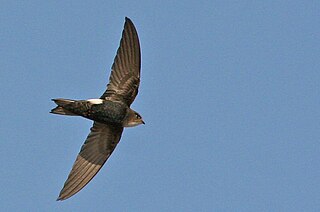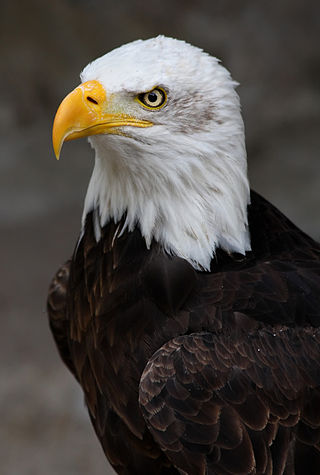
Horus, also known as Heru, Har, Her or Hor in Ancient Egyptian, is one of the most significant ancient Egyptian deities who served many functions, most notably as god of kingship, healing, protection, the sun and the sky. He was worshipped from at least the late prehistoric Egypt until the Ptolemaic Kingdom and Roman Egypt. Different forms of Horus are recorded in history, and these are treated as distinct gods by Egyptologists. These various forms may be different manifestations of the same multi-layered deity in which certain attributes or syncretic relationships are emphasized, not necessarily in opposition but complementary to one another, consistent with how the Ancient Egyptians viewed the multiple facets of reality. He was most often depicted as a falcon, most likely a lanner falcon or peregrine falcon, or as a man with a falcon head.

Birds of prey or predatory birds, also known as raptors, are hypercarnivorous bird species that actively hunt and feed on other vertebrates. In addition to speed and strength, these predators have keen eyesight for detecting prey from a distance or during flight, strong feet with sharp talons for grasping or killing prey, and powerful, curved beaks for tearing off flesh. Although predatory birds primarily hunt live prey, many species also scavenge and eat carrion.

Barn-owls are one of the two families of owls, the other being the true owls or typical owls, Strigidae. They are medium to large owls with large heads and characteristic heart-shaped faces. They have long, strong legs with powerful talons. They also differ from the Strigidae in structural details relating in particular to the sternum and feet.

The Accipitriformes are an order of birds that includes most of the diurnal birds of prey, including hawks, eagles, vultures, and kites, but not falcons.

The Coraciiformes are a group of usually colourful birds including the kingfishers, the bee-eaters, the rollers, the motmots, and the todies. They generally have syndactyly, with three forward-pointing toes, though in many kingfishers one of these is missing. The members of this order are linked by their “slamming” behaviour, thrashing their prey onto surfaces to disarm or incapacitate them.

Sagittariidae is a family of raptor with one living species—the secretarybird native to Africa—and a few fossil taxa.

Hotepsekhemwy is the Horus name of an early Egyptian king who was the founder of the Second Dynasty of Egypt. The exact length of his reign is not known; the Turin canon suggests an improbable 95 years while the ancient Egyptian historian Manetho reports that the reign of "Boëthôs" lasted for 38 years. Egyptologists consider both statements to be misinterpretations or exaggerations. They credit Hotepsekhemwy with either a 25- or a 29-year rule.

The Eye of Horus, also known as left wedjat eye or udjat eye, specular to the Eye of Ra, is a concept and symbol in ancient Egyptian religion that represents well-being, healing, and protection. It derives from the mythical conflict between the god Horus with his rival Set, in which Set tore out or destroyed one or both of Horus's eyes and the eye was subsequently healed or returned to Horus with the assistance of another deity, such as Thoth. Horus subsequently offered the eye to his deceased father Osiris, and its revitalizing power sustained Osiris in the afterlife. The Eye of Horus was thus equated with funerary offerings, as well as with all the offerings given to deities in temple ritual. It could also represent other concepts, such as the moon, whose waxing and waning was likened to the injury and restoration of the eye.

Quercy is a former province of France located in the country's southwest, bounded on the north by Limousin, on the west by Périgord and Agenais, on the south by Gascony and Languedoc, and on the east by Rouergue and Auvergne.

Strigogyps is an extinct genus of prehistoric bird from the Middle Eocene to Early Oligocene of France and Germany. It was probably around the size of a large chicken or a guan, weighing not quite 1 kilogram (2.2 lb). Apparently, as indicated by the ratio of lengths of wing to leg bones, S. sapea was flightless. Its legs were not adapted to running, so it seems to have had a walking lifestyle similar to trumpeters. Unlike other Cariamiformes, which appear to have been mostly carnivorous, Strigogyps specimens suggest a herbivorous diet.
Quercypsitta is a genus of prehistoric bird from the Late Eocene Quercy phosphorites in France.

The Horus swift is a small bird in the swift family Apodidae that is found in sub-Saharan Africa. Horus, whose name this bird commemorates, was the ancient Egyptian god of the sun, son of Osiris and Isis.

The Cathartiformes order of scavenging birds includes the New World vultures and the now-extinct Teratornithidae. Unlike many Old World Vultures, this group of birds lack talons and musculature in their feet suitable to seize prey. In the past, they were considered to be a sister group to the storks of the order Ciconiiformes based on DNA–DNA hybridization and morphology. However, a 2021 analysis of mitochondrial genes suggested a stronger the phylogenetic relationship between Cathartiformes and subfamilies of Accipitriformes.

Sneferka was an early Egyptian king who may have ruled at the end of the 1st Dynasty. The exact length of his reign is unknown, but thought to have been very short and his chronological position is unclear.

Ba, also known as Horus Ba, is the serekh-name of an early Egyptian or ancient Egyptian king who may have ruled at the end of the 1st Dynasty, the latter part of 2nd Dynasty or during the 3rd Dynasty. Neither the exact length of his reign nor his chronological position is known.

Cariamiformes is an order of primarily flightless birds that has existed for over 60 million years. The group includes the family Cariamidae (seriemas) and the extinct families Phorusrhacidae, Bathornithidae, Idiornithidae and Ameghinornithidae. Though traditionally considered a suborder within Gruiformes, both morphological and genetic studies show that it belongs to a separate group of birds, Australaves, whose other living members are Falconidae, Psittaciformes and Passeriformes.

Horus Bird, also known as Horus-Ba, may have been a pharaoh who may have had a very short reign between the First and Second Dynasty of Egypt. Horus-Bird's burial site is unknown.

Horus Sa was a possible early Egyptian pharaoh who may have reigned during the Second or Third Dynasty of Egypt. His existence is disputed, as is the meaning of the artifacts that have been interpreted as confirming his existence.

Accipitrimorphae is a clade of birds of prey that include the orders Cathartiformes and Accipitriformes. However, this group might be a junior synonym of Accipitriformes. The DNA-based proposal and the NACC and IOC classifications include the New World vultures in the Accipitriformes, but the SACC classifies the New World vultures as a separate order, the Cathartiformes which has been adopted here. The placement of the New World vultures has been unclear since the early 1990s. The reason for this is the controversial systematic history of the New World vultures as they were assumed to be more related to Ciconiidae after Sibley and Ahlquist work on their DNA-DNA hybridization studies conducted in the late 1970s and throughout the 1980s. The stork-vulture relationship has seemed to not be supported. Regardless of whether to use Accipitrimorphae or Accipitriformes, these birds belong to the clade Telluraves.
Pelargopappus is an extinct genus of raptor related to the secretarybird that lived in early Miocene France. Only one species, the type species P. magnus is officially recognized. A second species, P. schlosseri from the mid-and late Oligocene, was split off into the genus Amphisagittarius.


















